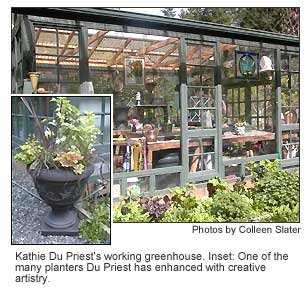 Kathie Du Priest is a creative gardener. Although she doesn’t consider herself an artist, visitors to her interesting garden think otherwise.
Kathie Du Priest is a creative gardener. Although she doesn’t consider herself an artist, visitors to her interesting garden think otherwise.
She sometimes copies expensive containers and garden art, but with other items, she simply thinks of an idea and checks it out. She has three basic rules for her various garden art projects: “It must be fun, easy, and inexpensive.” She notes that sometimes it takes a lot of patience, but none of her faux painting is difficult. For the past three years or so, imitating large antique urns has been a special interest. The large plastic pots available in nurseries and garden centers cost only a few dollars, and are lightweight. An early venture was to make one look like an old concrete container.
She sprayed on Fleck Stone® for texture, and after drying, sprayed a light layer of copper paint to highlight the stone effect. Acrylic paint was patted on with a scrunched-up plastic bag until she obtained the right color. When that coat was dry, she used the same technique with black paint.
She likes acrylic paint because if it isn’t turning out the way she expects, she washes it off with water and begins again. She now paints the pots first with a latex primer so the paint adheres better.
This year, she is working with a new method she invented herself. On a plastic urn with some raised decoration, she first used black. The craft paint is usually dry to the touch within an hour, and the next process can be done. On a paper plate, she squirted little blobs of white, black and brown paints. Her two-inch brush was dipped into each one consecutively — “no particular order” — and the excess wiped on an old towel. It is called a dry brush technique because there is only a little paint left on the brush.
After the container was covered with this mix of colors, she blotted it all over with a piece of towel until she had “just the right look.”
The finished product, with parts showing gray, white and brown, looks like aged concrete.
A second urn, with different colors, doesn’t please her as much. Since it’s too late to wash it off, she may figure out something to partially cover it to make it more attractive in her eyes. She recommends the use of the terra cotta sealer on all terra cotta pots, which helps avoid breakage.
Leaf or fruit stencils may be stuck to a pot using stencil adhesive.
Pre-mixed joint compound is applied with a putty knife. She used a cotton swab to apply some copper paint from a spray can to the dried raised figure. The pot was then set in the sun, and when dry, sprayed with undiluted Clorox® and left in a sunny area. The chemical reaction of the paint, bleach and sun eventually turn the stenciled area green. These “green pots” have lasted several years in her garden and still look good.
Whether traffic cones, cheap planters, or other discarded items, Du Priest’s garden is a special delight for her many visitors.
UNDERWRITTEN BY THE FUND FOR NONPROFIT NEWS (NEWSMATCH) AT THE MIAMI FOUNDATION, THE ANGEL GUILD, ADVERTISERS, DONORS AND PEOPLE WHO SUPPORT INDEPENDENT, NONPROFIT LOCAL NEWS